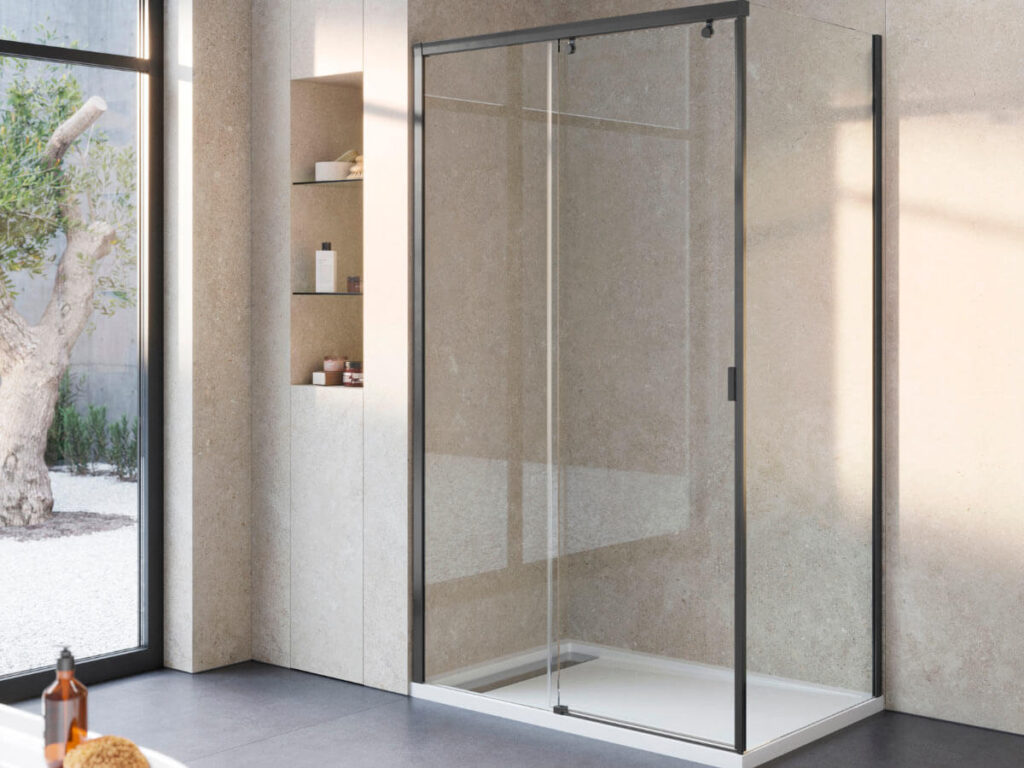In this article, we'll look at the advantages and disadvantages of shower enclosures made from structured glass. These enclosures bring a modern, elegant look to your bathroom. HoweverBut they can also be more expensive than other options, and require regular maintenance to avoid water marks and stains. We offer a detailed analysis to help you make the best decision for your bathroom.
All-in-one waterproofing with wedi - Ep 63
[arve url="https://www.youtube.com/embed/ejlH9L6-Hys "/]
What type of glass for a shower enclosure?
For a shower enclosure, you have several options when it comes to the type of glass:
- Tempered glass is generally recommended for shower enclosures. It is more resistant to impact and safer because it shatters into small, non-sharp pieces.
- Clear glass is a classic choice that allows you to see through the wall, which can give the bathroom a feeling of spaciousness.
- Frosted glass offers greater privacy by blurring the view through the wall. This can be a good choice if you want to preserve your privacy while letting light through.
- Tinted glass is a great option if you want to add a splash of color to your bathroom. There are a variety of shades available to match your decor.
It's important to choose quality glass and call in a professional to install the shower enclosure to ensure safety and durability.
What material should a shower enclosure be made of?
What material should a shower enclosure be made of?
The choice of material for a shower enclosure is crucial to the durability and aesthetics of your bathroom. Here are some popular options:
1. The glass : Glass is the most commonly used material for shower enclosures. It offers a transparency that gives a feeling of openness and lightness to the bathroom. What's more, it's easy to clean and stain-resistant.
2. Plastic : Plastic is an economical option for shower enclosures. However, it is less durable than glass and can discolor over time. It's best to opt for a high-quality plastic, such as polycarbonate, which is more impact-resistant.
3. Stainless steel : Stainless steel is extremely resistant to corrosion and offers a modern, elegant appearance. Stainless steel shower enclosures are often associated with contemporary designs.
4. Tiling : Tiling is a versatile option for shower enclosures. It can be customized to suit your tastes and offers a wide variety of colors and patterns. However, it requires regular maintenance to prevent the build-up of mold and moisture.
In conclusion, the choice of material for a shower enclosure depends on your personal preferences, your budget and the overall aesthetics of your bathroom. It's advisable to consult a professional to determine the best option for your specific needs.
How to avoid water marks on shower enclosures?
To avoid water marks on shower enclosures, here are a few tips:
1. Use a scraper or squeegee after every shower : After you've showered, use a scraper or squeegee to remove the water from your shower walls. This will prevent the formation of traces or deposits of limescale.
2. Clean your shower enclosures regularly : It's important to clean your shower enclosures regularly to remove soap scum and limescale deposits, which can lead to the appearance of water marks. Use a specific bathroom cleaner or a mixture of water and white vinegar to clean effectively.
3. Apply an anti-stain product : Some brands offer specific products to prevent the appearance of water marks on shower enclosures. These can be applied after each cleaning to make shower enclosures more resistant to streaking.
4. Ventilate your bathroom properly : Make sure you have good ventilation in your bathroom to remove moisture quickly. Excessive humidity can lead to streaking of shower enclosures.
5. Use a microfiber cloth : When cleaning your shower enclosures, use a microfiber cloth. This will effectively remove water and prevent streaking.
By following these tips, you can keep your shower enclosures clean and free of water marks.
How long do I need a shower enclosure to prevent splashing?
To avoid splashes in your bathroom, we recommend installing a shower screen of adequate length. The optimum length of a shower enclosure depends on several factors.
First of all, the size of your shower area is important. If you have a small shower, a shorter enclosure may be sufficient to prevent splashes. However, if you have a large shower, a longer enclosure will be necessary to effectively protect the rest of the bathroom.
The type of faucet or showerhead used can also influence the required length of the shower enclosure. Some showerheads produce a powerful spray that can lead to larger splashes. In this case, it's best to opt for a longer shower screen to contain the extra splash.
Finally, the position of the showerhead in relation to the shower panel can also play a role in preventing splashes. If the showerhead is positioned close to the wall, a longer wall will be needed to cover a larger surface area.
It's important to take these factors into account when choosing the length of your shower enclosure. Don't hesitate to ask a bathroom professional for advice to help you determine the ideal length for your specific needs.
In conclusion, choosing a glass shower enclosure has both advantages and disadvantages. On the one hand, glass lends a modern, elegant aesthetic to the bathroom, creating a feeling of space and luminosity. What's more, its transparency enhances visibility and facilitates cleaning. HoweverHowever, it should be noted that glass can be fragile and requires regular maintenance to avoid water marks and stains. In addition, the wrong choice of glass or incorrect installation can lead to safety problems. It is therefore essential to use qualified professionals for installation, and to take these factors into account when deciding on a glass shower enclosure. By weighing up the pros and cons, everyone can choose the best option to suit their aesthetic preferences and specific bathroom needs.








